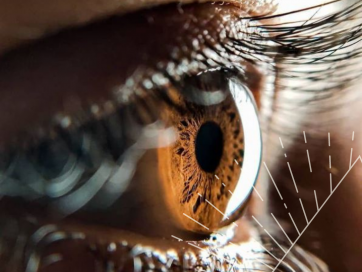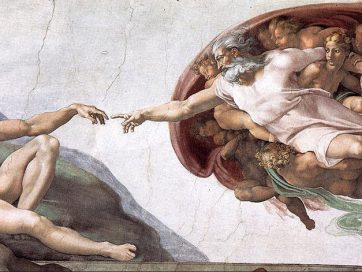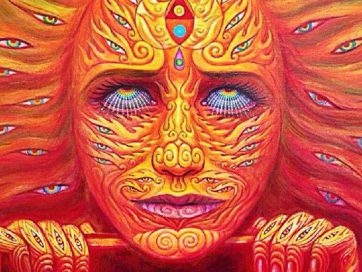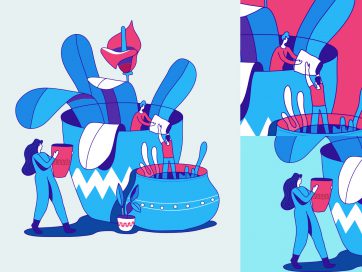
The Impact that Changed the Earth
Flower Power continues to generate effects, and the disruption dreamed in the 1960s has come true and remains a trend of the future thanks to Hippies 2.0
Rodrigo Rocha
A physics issue: collisions always generate energy. Big collisions can change the world, put an end to entire eons. The study of dinosaurs proves this. Regardless of a creature’s strength, a large enough collision can change everything and even completely annihilate an ecosystem. But there are also small collisions that change only what is around them. And there is friction, even smaller and constant collisions, which also generate heat, wear and noise. Well then, when we think of the hippie movement of the 1960s, there are those who say that it was mere friction, a colorful but outdated fad. Many, however, believe it was a collision between the establishment and a new approach to life that shaped an entire generation. And there are those who see the hippie movement as one of those meteorites that change the environment of the entire planet, that subliminally and profoundly alter people so much that they become the DNA of many of the attitudes we see today in people. This profound change certainly drives consumer preferences and thus determines trends in the business world and in macroeconomics.
The meteorite that caused all this change was called beat generation”. Coined in 1948 by author Jack Kerouac, this definition of the lifestyle of a generation eventually spread to American literature in the late 1950s through the texts of John Clellon Holmes and Allen Ginsberg. In their novels and poems they spoke of behaviors that collided spectacularly with the thought structure of the American middle class – moralistic, conformist and racist. These young writers sought inspiration in the underworld, in the excluded, the bohemians, artists and musicians, people who led a lifestyle deemed dangerous, sinful and decadent by proper middle-class families who raised their children to be corporate professionals, to sleep early and wake up with the chickens. The young people of the beat generation embraced drugs and wanted to “live fast and die young”. They were the root of nonconformity brought about by an awareness that fate prepared for them by their parents, teachers and bosses was too tedious to be faced stone sober. The way out was rebellion and the pursuit of adrenaline – the most licit of drugs. This uneasiness was portrayed in the film Rebel without a cause, starring James Dean. The actor, who was an ambiguous sex symbol, lived in real life many of the excesses he portrayed in the movies. Having died in a car accident at age 27, he became an icon of this extreme way of living. That generation was for America what the Impressionists had been in Paris at the turn of the 20th century.
However, much like the impact of a meteor on the Earth’s crust, the beatniks’ ideals have been generating waves of consequences and getting into the head of young people over the years. It took almost 20 years, but the concept of counterculture established itself in the minds of young people. Universities in California, especially those closest to San Francisco like Berkeley and Stanford, became venues where these ideas amplified into an even more radical and broader movement: the hippies, who literally flourished in 1967 in the so-called “Summer of Love.” That summer, nearly 100,000 people went to the San Francisco area – the city where jeans were born almost a century earlier, in 1873, and has always been known for being innovative and a place of excess since the days of the Gold Rush of the 19th century. In the 20th century, however, San Francisco’s gold would take on another form. What was being mined in the late 60s and early 70s were ideals that would shatter standards – it was the age of Flower Power.
At that moment (1967), everything was happening there (Bay area). There were protests against the Vietnam war on the campus of Berkeley. It was also in that summer that Oakland’s African-American revolutionary movement, the Black Panthers, marched into the state capital, bearing arms without hiding it from anyone. Bands such as Grateful Dead, Jefferson Airplane and Big Brother and the Holding Company, led by Janis Joplin, performed onstage at venues such as the Avalon and the Fillmore, their acid-drenched psychedelics expressing the concerns of the counterculture – ranging from surrealism to free sex.
That summer, dancers Rudolf Nureyev and Margot Fonteyn (paragons of the classic culture beloved by the establishment) were arrested while at a party in the Haight-Ashbury neighborhood (the epicenter of the hippie movement) that was raided by the police. At the scene, the law men found marijuana cigarettes. At the time of his arrest, Nureyev lampooned the situation in high-style and made a “jeté” as he got into the police car. The dancers were eventually released because there was no proof they had smoked the drug.
The effervescence at that time was enormous. Everything was done to make clear that that generation repudiated the values of conventional society, with its racism, war and repression. It was better to build alternative realities, and that meant doing the opposite of what the middle classes did – in every field. In fashion, different volumes, vibrant colors, gaudy prints, oriental influence, long hair and beards, repudiation of hair removal. In eating, non-industrialized, natural, macrobiotic, vegetarian food. It was the time of the emergence of nudism, of living in communes, of free love. The struggle was for equality and preservation of nature, and against war and militarism. It was the time when many discovered the Eastern religions, began to seek gurus and achieved a new dimension of spirituality. Numerous sects emerged at this time. Music was an important factor in behavioral change. The Beatles’ 1967 album, Sgt. Pepper’s Lonely Hearts Club Band, was a call to the counterculture that hit both America and Europe. Two weeks after its release on June 1, it was heard through the loudspeakers of Monterey Pop, arguably the first music festival – held, not by chance, in a coastal city of northern California, near San Francisco.
All this counterculture broth penetrated the minds of academics and formed the values of the generation born in the 1950s, the Baby Boomers, who changed the face of business and the way of life of everyone. No one can deny that Microsoft has changed our society. It was founded on April 4, 1975 by Bill Gates, born in Seattle in 1955, and Paul Allen, who was two years older. Another company that changed habits, created new aesthetics and revolutionized people’s lives was Apple, founded on April 1, 1976 by Steve Jobs, born in 1955 in San Francisco, and Steve Wozniak, who is from 1950. In addition to having literally grown up at a time and place where hippie influences were very strongly heartfelt, these creators attended universities that even today cultivate a critical view of society.
Microsoft and Apple were born in garages, founded by young men full of potential who preferred to drop out their university courses to undertake – attitudes considered highly rebellious in the 1970s. At that time, the script called for a young man to earn a degree, get a job on a multinational, wear a suit, take out a mortgage, save to send his children to college, and retire. But these children of the hippie movement did nothing of the sort. They created a series of subversive products and services, and developed corporate cultures that challenged classic industrial models. Constant innovation, aesthetics, different ways of conceive looking at work, proposals for a new relationship with consumers, individual empowerment through the use of technology – all this came with this generation nurtured by the ideas of the hippies.
The patterns created by these companies served as an example for other companies with formats and attitudes even further away from the classic framework of management and economics that had been established in the late 19th century, in the Second Industrial Revolution. Apple makes computers and other devices, Microsoft sells its programs on physical media. The companies that came after do not deliver anything physical, yet their services and performance are no less powerful – quite the contrary! Google, Facebook, WhatsApp and Waze have never delivered anything physical and are among the most valued companies and brands in the world because they clearly make people’s lives better. They effectively empower people, break down barriers, bring people together, allow ideas and communication to flow, and bring a sense of community – so important to hippies, who deplored individualism – to the core of their operations.
Platforms like Apple Store, Airbnb and Uber have elevated cooperation and a sense of sharing to a whole new level. That is why, before even making a profit, Uber had such a buzzed-up and marked-expectation fueled IPO. WhastApp was bought by Facebook for $ 19 billion without ever making a profit. It was a company with mere 55 employees that challenged the big telcos upfront – it’s subversive and disruptive. All this indicates that we are living a third phase of the hippie movement.
In fact, most companies and brands highly valued by people around the world fulfill the hippie aspirations in the sense that they are based on community values, sharing, inclusion and accessibility. Nowadays, even shaved and fully hairless people who wear gray clothes and are more concerned with credit card bills than with global warming (which would spell the end of the world) are living immersed in hippie culture – without ever being aware of it!
More and more people who are active in the market today adopt a behavior linked to constant innovation and with that challenge the limits and behaviors attributed to their generations of origin. These are the Perennials – people who evolve all the time and who establish for their lives an attitude of unrestricted openness to the new and novel.
There is a whole way of living based on conscious consumption and the pursuit of balance. One reflection of this is the dissemination of Yoga over the last 20 years as physical exercise and therapy for the soul. Throughout the world, millions practice the ancient art of Yoga and meditation to reduce stress and evolve spiritually. Another line of Oriental thinking that has been gaining more and more adepts is Traditional Chinese Medicine which, long before penicillin, x-rays, CT scans and MRI equipment, carried out diagnoses and treatments based only on observation of patients and how their energy flowed. Five thousand years ago, Chinese healers already preached that health is the result of the connection between mind, body, spirit and environment.
There are many new things happening in our world. The search for self-knowledge inaugurated by hippies has been affecting everything and is even generating a new way of looking at work. Professionals want more than a salary, they want to do a job that has meaning for themselves and for the world. They want to be better people and strike the balance between “high tech” and “high touch.” This attitude has come to be called Hippie 2.0 and is changing how business is carried out and how companies structure themselves.
A Gallup survey in 142 countries assessed employee engagement and found that 13% of them feel engaged. On the other hand, The Energy Project found that people are three times more likely to stay at work, are twice as happy, and are more motivated when work is meaningful. But the great wave of the world of work is the shift from employment to entrepreneurship. More and more people – of all ages – are forgoing corporate reality to pursue a dream, a purpose, and this leads them to open their own garage companies. Incidentally, it should be noticed that ultra-successful startups are called unicorns – a mythological animal that has everything to do with the dreamlike visions of the hippies. Some of today’s most successful business initiatives are responses to the dreams of the Flower Power age. For example, the automaker Tesla, which arose to provide for those who would pay any price to use clean energy. Beyond Meat, a company that proposes to offer vegetable protein with the aesthetics of traditional food without impacting the environment. With a product line of hamburgers, hot-dogs and sausages made from vegetables, legumes and greeneries, the company won over vegetarians while respecting mainstream gastronomic culture. With this, the company attained a market cap of $ 5 billion in 2019 – in a country of avid carnivores like the United States.
But there are other behaviors and attitudes that reinforce the existence of a new way of being hippie: more and more people prefer public transportation and Uber to owning a car – one of the main symbols of the Second Industrial Revolution. In fact, people increasingly want fewer and fewer physical things. Culture always arrives on-demand, through streaming, via Netflix, Spotfy and Kindle. Mass media is being confronted by blogs and YouTube. There has never been as much organic and vegan food available. Today not only sex is free, sexuality itself has become free. People can make their own decisions about gender, families take on the broadest range of formats and religion has become the personal, spiritual decision of each one. People want freedom, but they demand accountability of anyone who wants to offer them a product or service. Even the relationship with drugs and psychedelics has changed radically. In several places around the world – Netherlands, Canada, California, Colorado, Uruguay – marijuana is legalized and sold in an organized way. Nureyev would love it!
More than 50 years after the Summer of Love, we see that the hippies have won and it’s we can already say that their impact on Earth managed to change everything in the life of the planet. There are still some dinosaurs who are trying to resist, but the new world created by hippies – both the originals and today’s – is inexorable. Peace and love!







